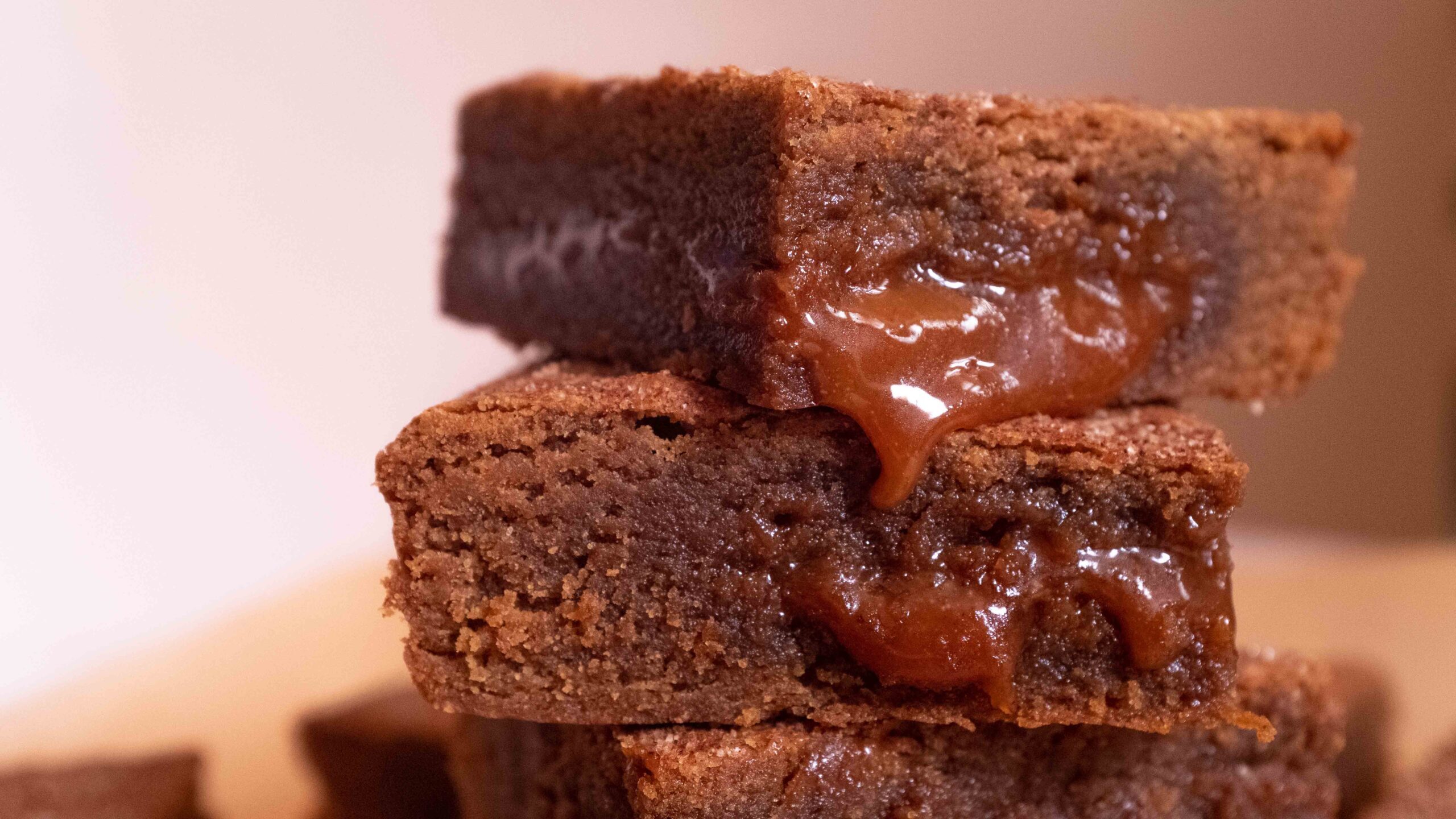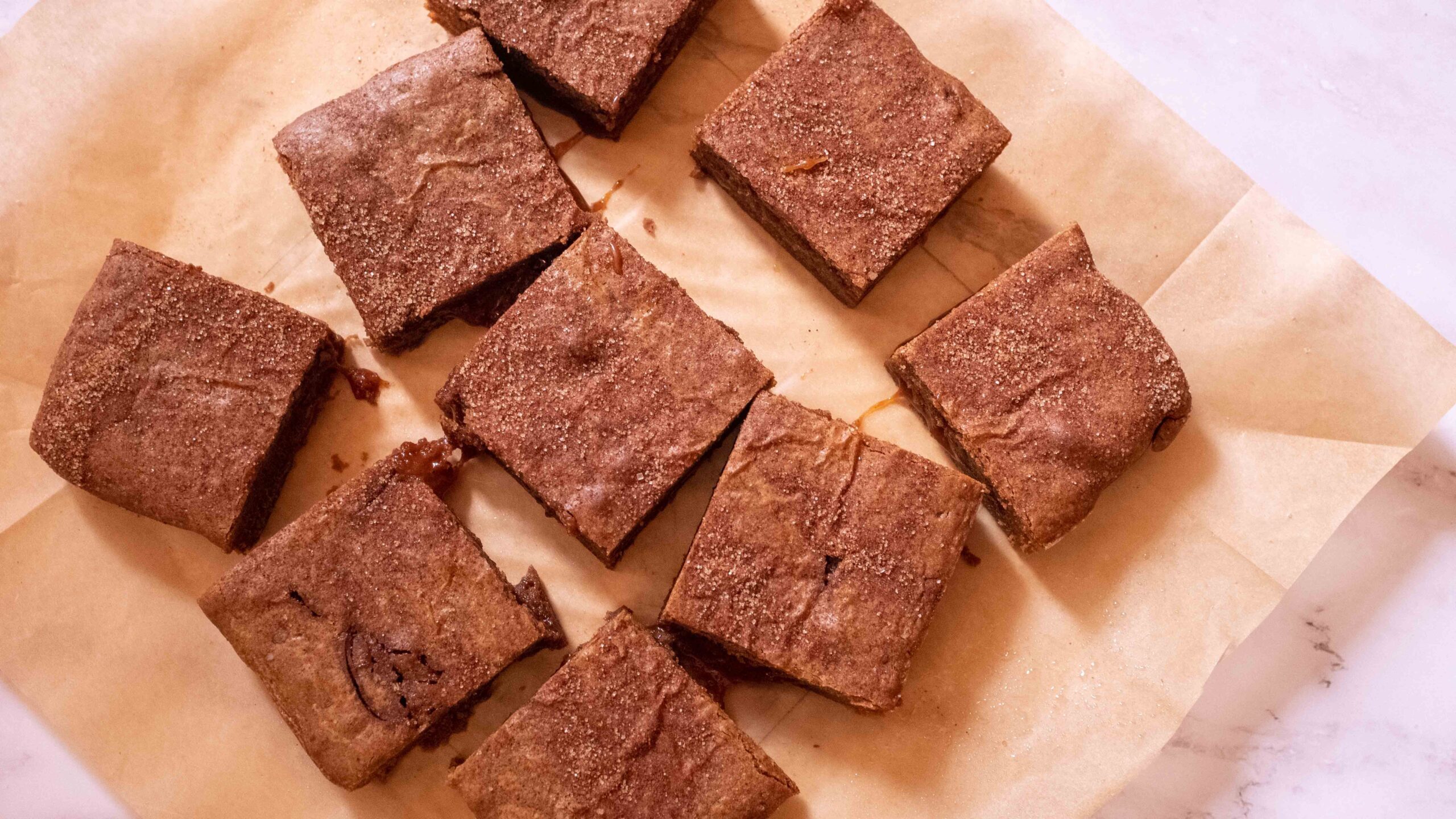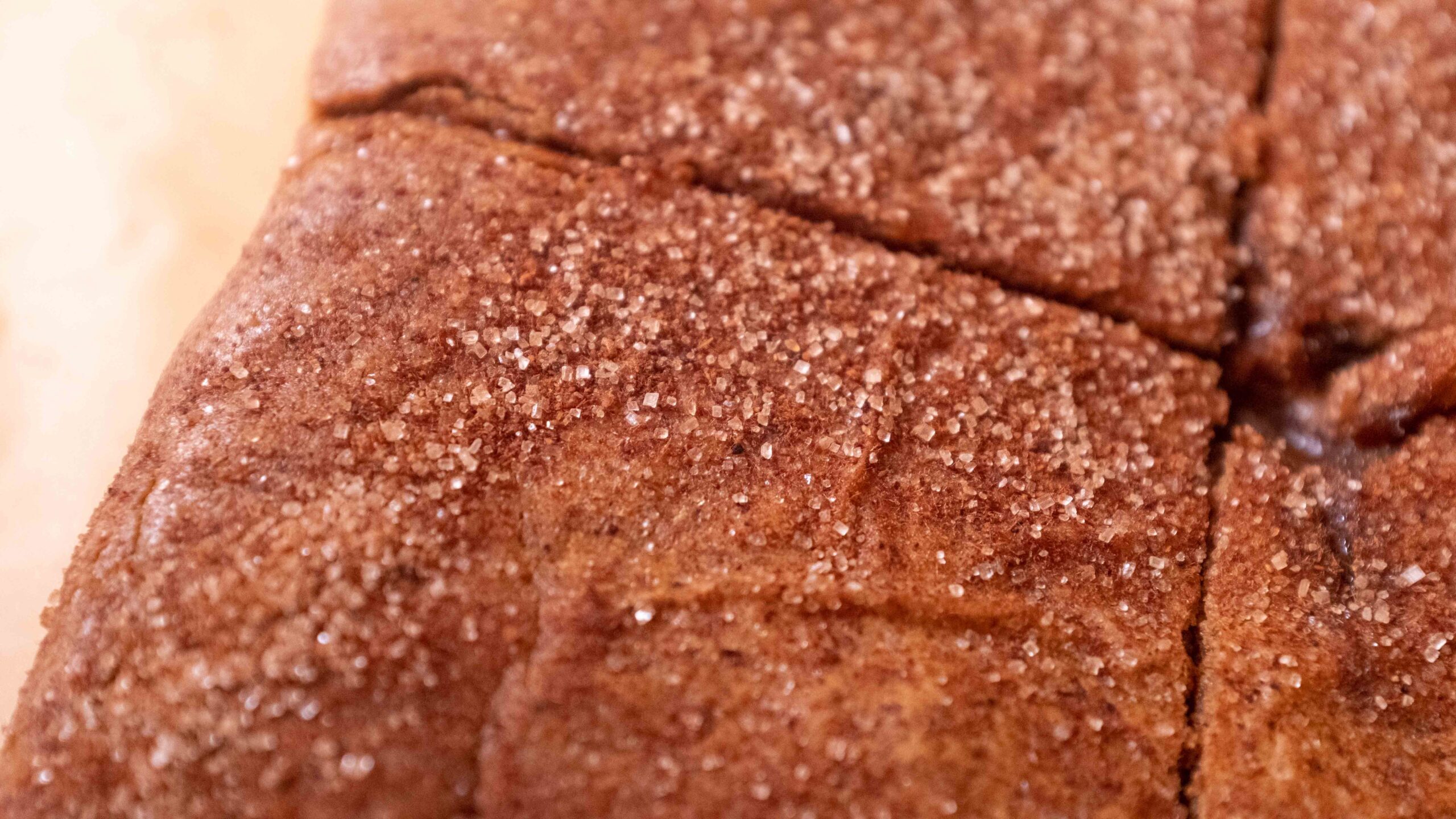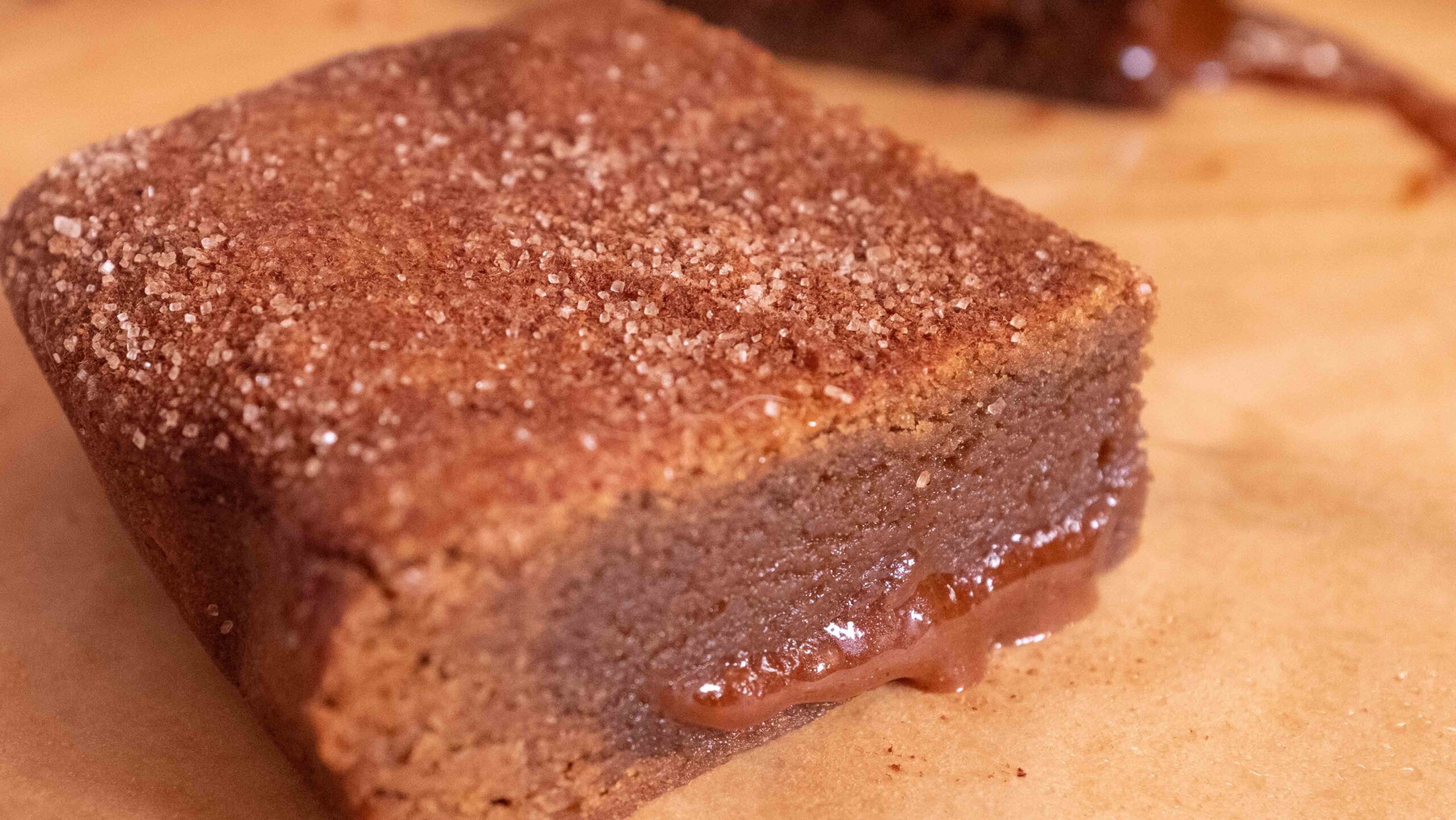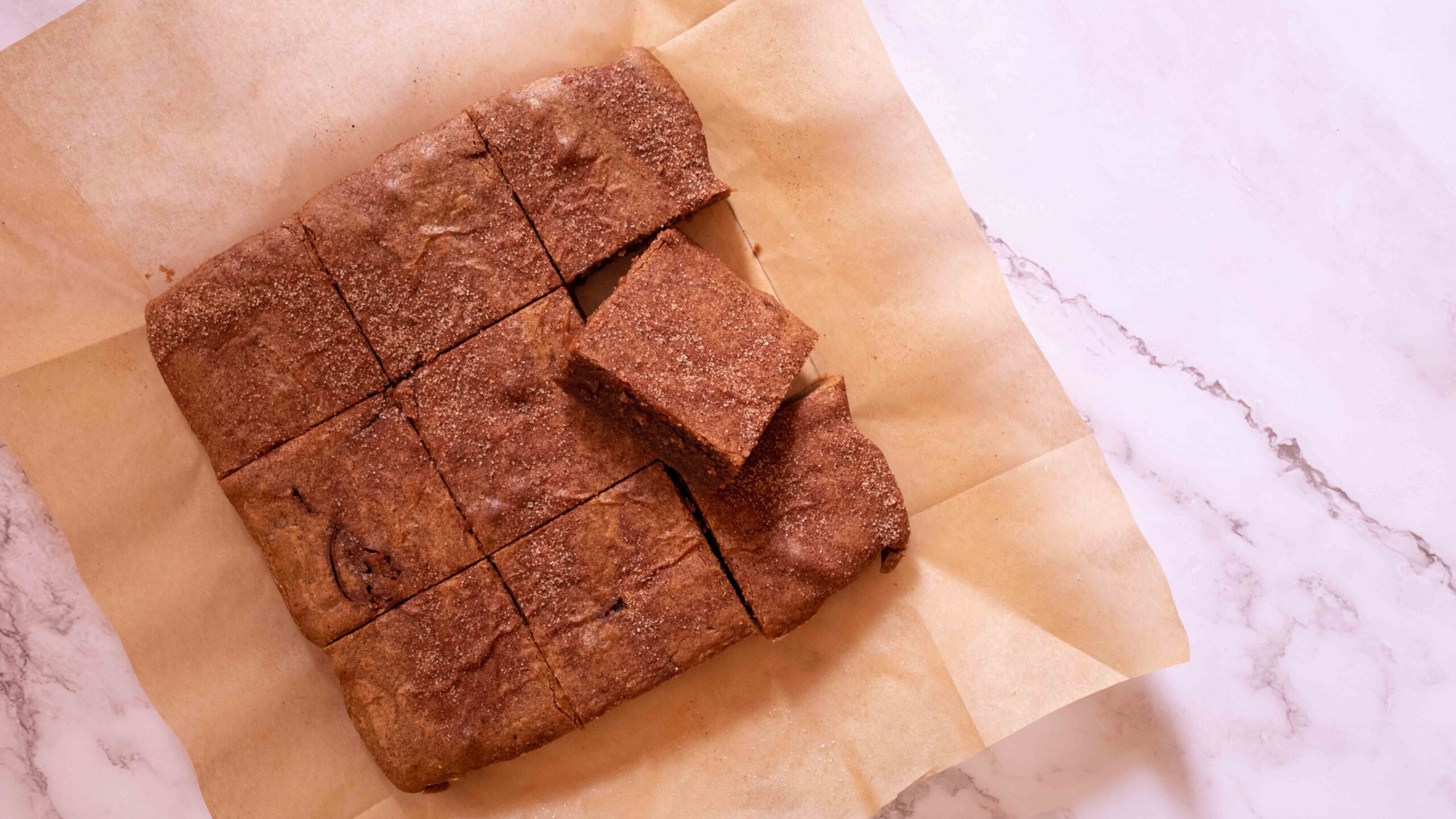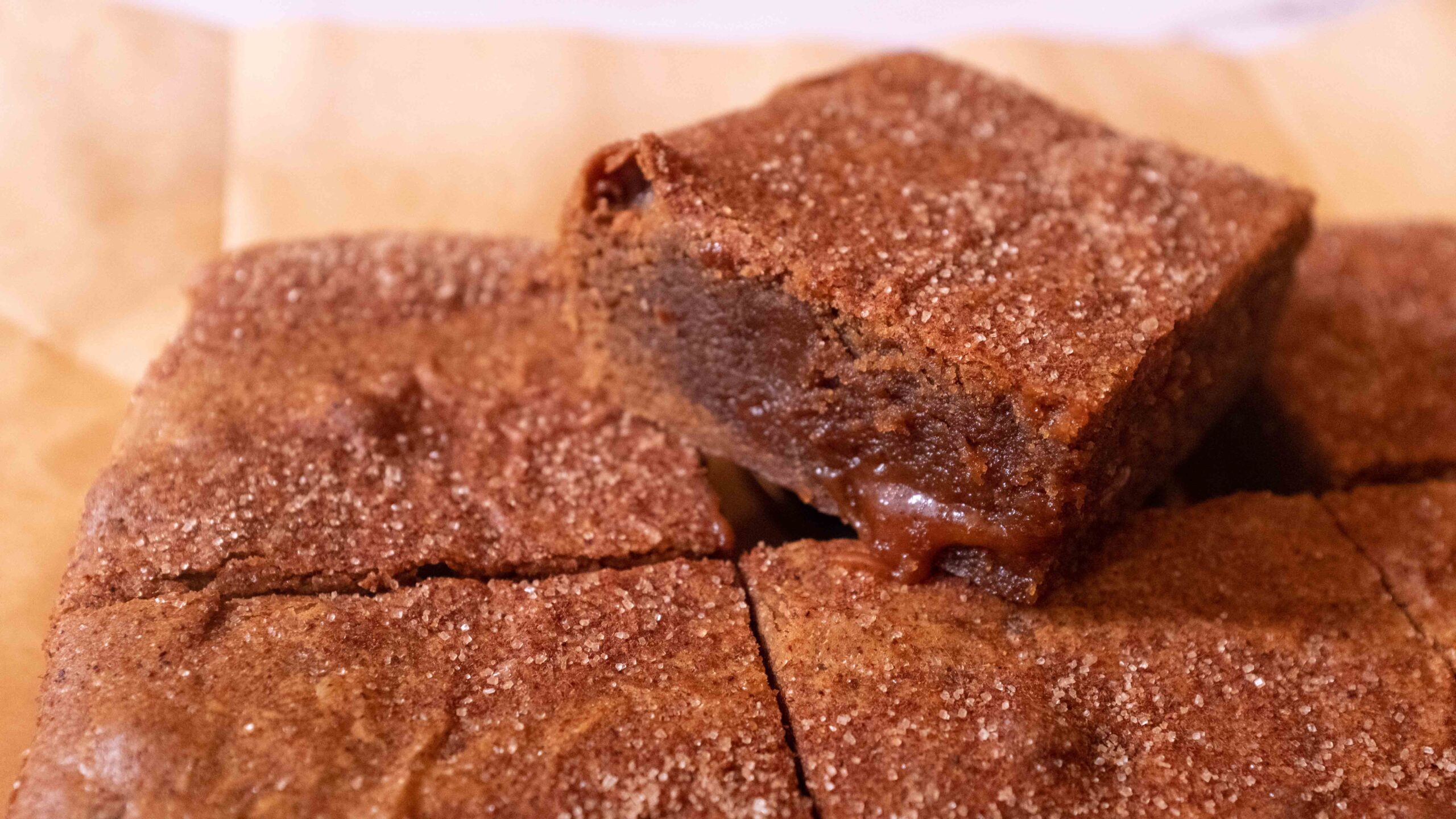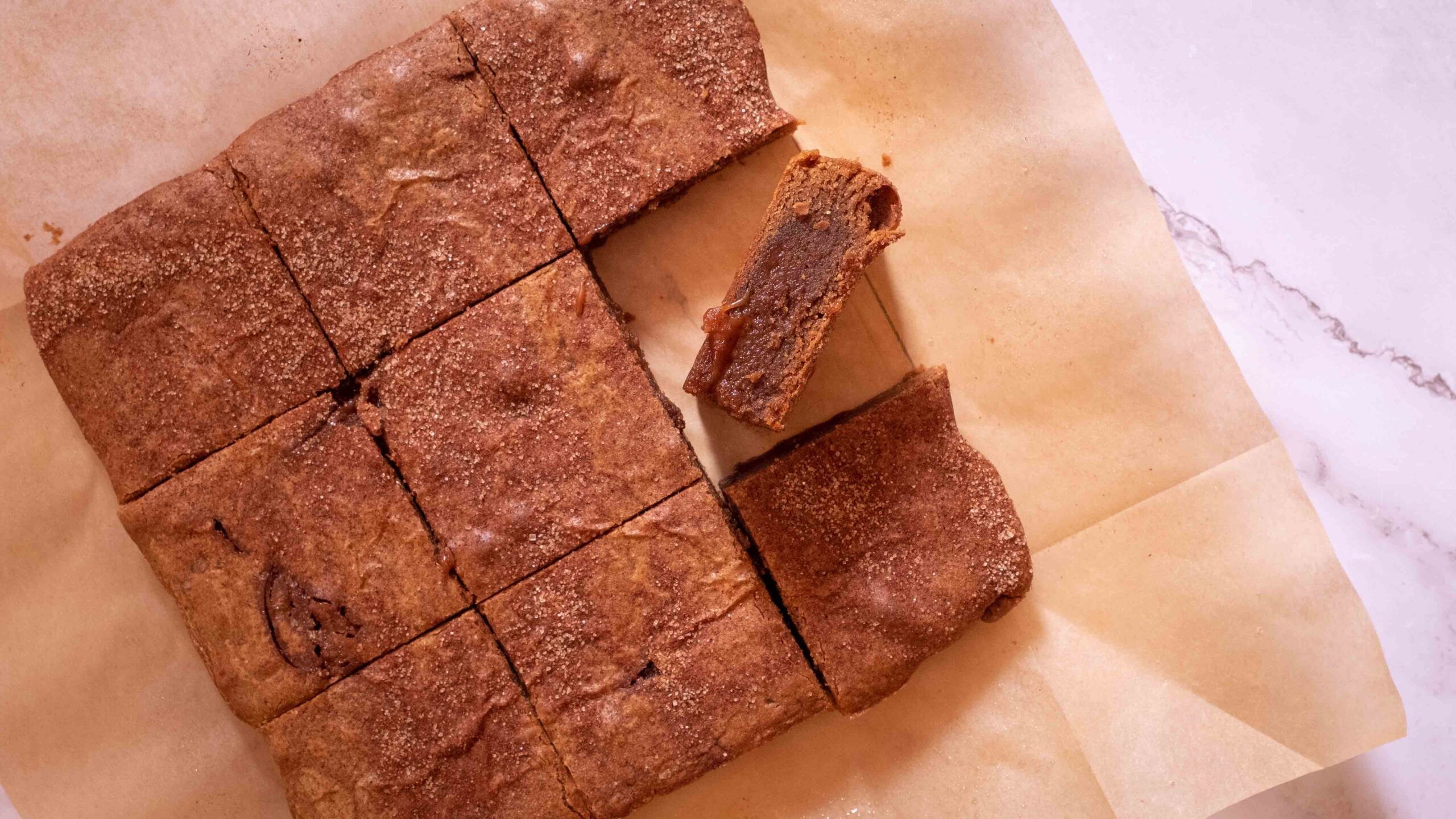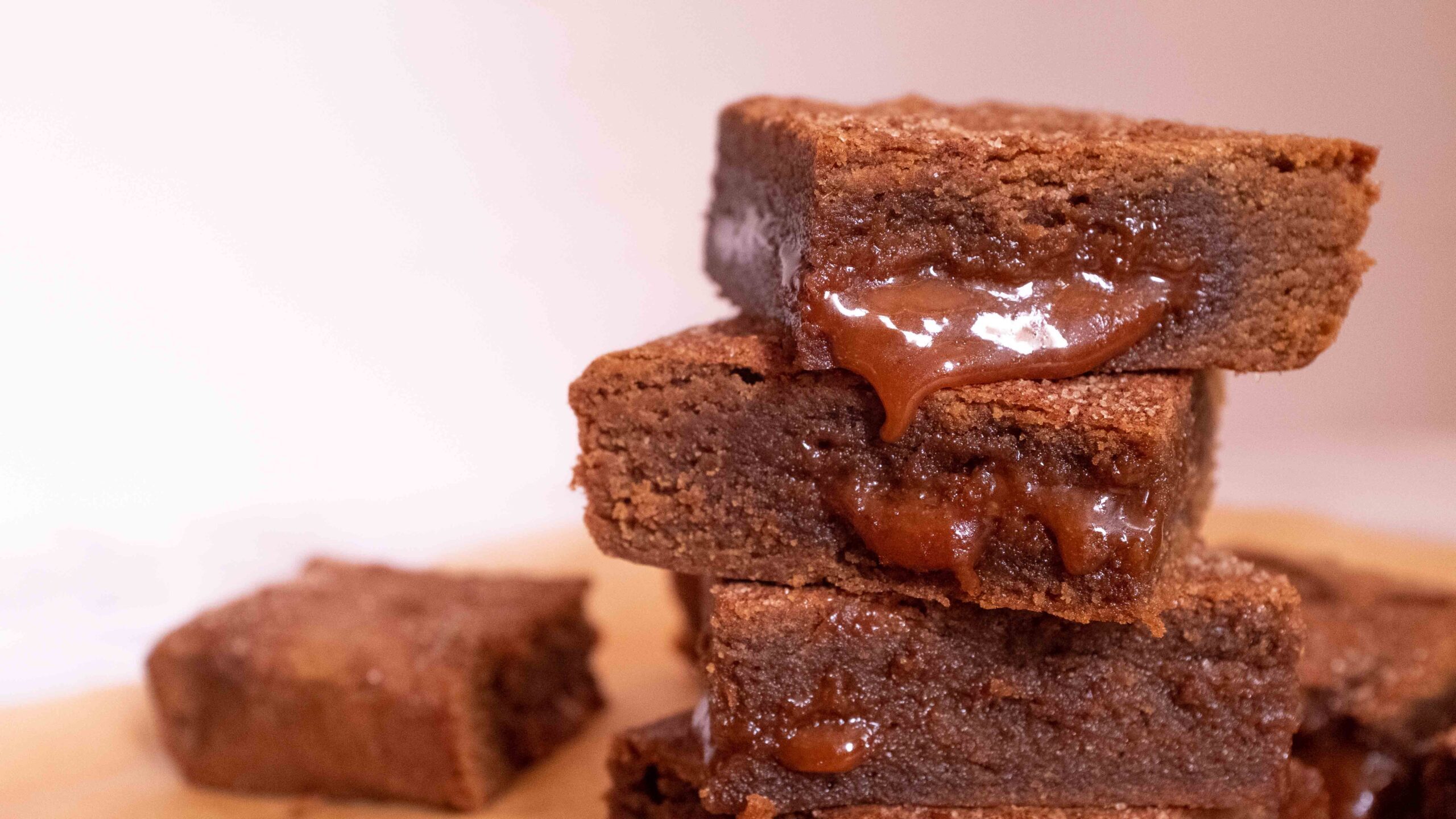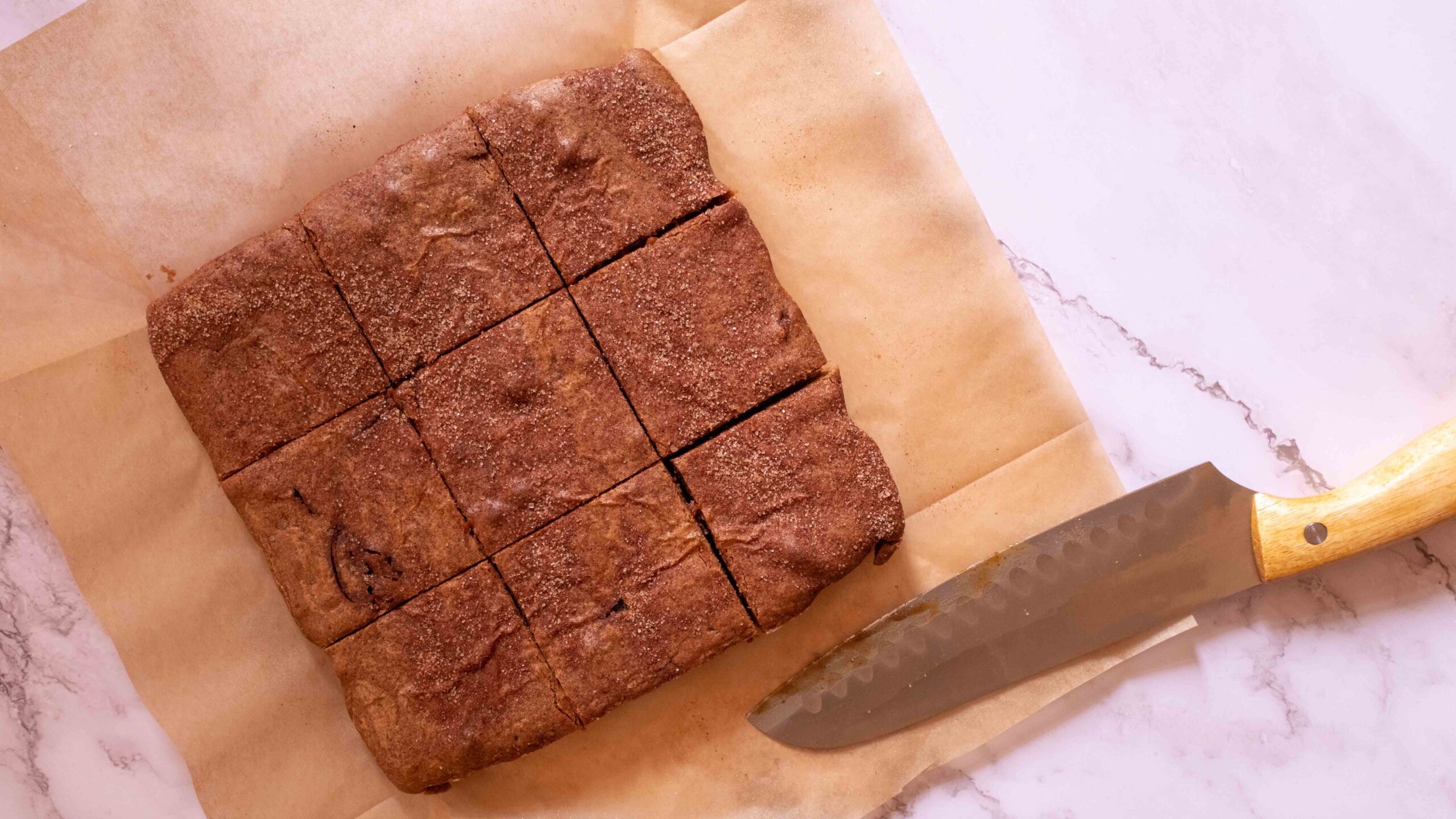Makes 9 blondies; 2 ½ x 2 ½ inches, each.
If my Fudgilicious Brownies are a bitter-sweet indulgence for adult palates, my Stickylicious Blondies will straight up appeal to the sweet-craving child in you. Moist with butterscotch and sticky with caramel, each bite brings the warmth of cinnamon, the sweetness of vanilla, and the crunch of coarse sea salt. With its crusty top and squishy insides, these blondies are chewy, gooey, and totally scrumdiddlyumptious. Bring napkins. This could get messy.
At a glance
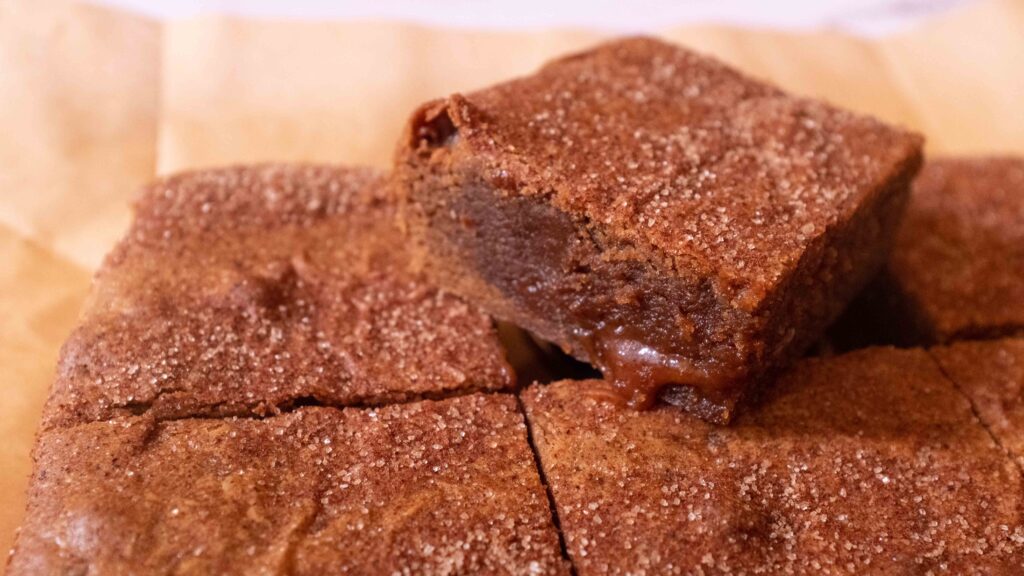
– You will need a medium, heavy-bottomed steel saucepan, an 8 inch square metal brownie pan, and baking parchment.
– This recipe has been broken into 3 stages for ease and comprehension. Please read the entire recipe from start to finish before beginning.
Stage 1: make the cinnamon-caramel goop
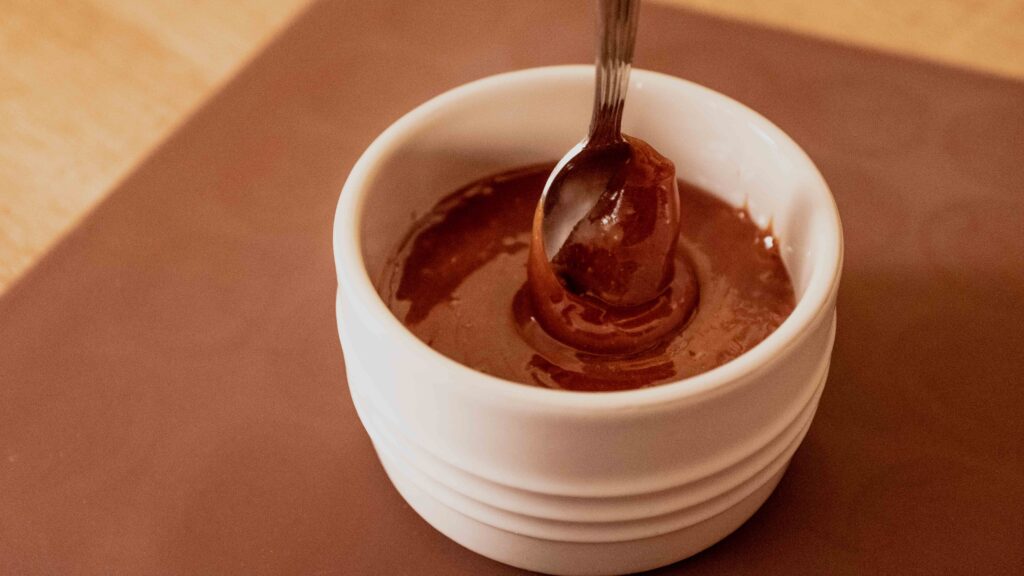
Even though blondies have a distinct caramel-like taste, they’re actually made with brown sugar and melted butter, which is the base for butterscotch. Read about the difference between butterscotch and caramel here. In my blondies, I have added a caramel layer for extra flavour and stickiness. Because no one should have to choose between butterscotch and caramel, right?
Ingredients
1. 110 gm white castor sugar
2. 30 ml corn syrup
3. 15 ml water
4. 45 ml heavy cream, at room temperature
5. ½ tsp vanilla extract
6. 10 gm butter, at room temperature
7. 1 tsp coarse sea salt
8. 1 tsp cinnamon powder
Method
1 – Combine the vanilla and heavy cream in a small jug and set it aside.
2 – Take a medium, heavy-bottomed steel saucepan. Place the sugar, the corn syrup, and the water inside, and give it a stir.
3 – Place the saucepan on medium heat. You can stir the mixture at this point to encourage the sugar to dissolve. Once the sugar has dissolved, stop stirring and pop the lid on. This is the easiest way to prevent your mixture from crystallizing, as the condensation formed will drip down and melt any stray sugar particles on the sides of your pan. If you’re worried about uneven heating, swirl the entire pan on the hob. Do not stir wet caramel. Ever.
4 – Watch your saucepan like a hawk, lifting the lid to peek at the mixture every now and again. Once the water has completely boiled away, and the remaining sugar is a pure, clear liquid (160OC), lower the heat to minimum and take the lid off.
5 – As soon as the caramel turns amber (170-173OC), start paying close attention.
6 – Once the caramel is a nice medium-dark amber, (174-176OC) take the pan off the heat. Whisking continuously, very slowly and carefully trickle in the cream, leaving about a tablespoon’s worth in the jug. Continue whisking, until you have a smooth, homogenous, velvety sauce.
7 – Once the mixture has stopped bubbling and steaming, add the butter, the coarse sea salt, and the cinnamon. Whisk until the butter has fully melted and emulsified into the sauce. Let the sauce cool for about 5 minutes.
8 – Finally, stir in the remaining cream. Bring the goop to room temperature or just warm before using. Cinnamon-caramel goop is ready. Set it aside.
If you’ve never made caramel before, read this and this. Because this cinnamon caramel goop will be baked into the batter, it is waaaaaay thicker in consistency than my Salted Caramel Sauce, which is ideal for pouring over desserts. This component can be made ahead of time and stored in an airtight container in the fridge. When you’re ready to bake your blondie, gently warm the goop in the microwave for 10 seconds at a time to bring it back to a ‘scoopable’ consistency.
Stage 2: make the blondie batter
Blondies have the same richness and chewiness as a brownie, but the dominant flavours are vanilla and caramel rather than chocolate. While you can definitely fold in any kind of chocolate chips into the batter, you would never incorporate cocoa powder or melted chocolate into a blondie.
Ingredients
1. 200 gm all purpose flour
2. 1 tbsp. corn flour
3. 1 tsp baking powder
4. 1 tsp salt
5. 1 tbsp. cinnamon powder
6. 140 gm unsalted butter
7. 280 gm dark muscovado sugar
8. 1 large egg (57 gm in-shell weight) at room temperature
9. 2 egg yolks from large eggs at room temperature
10. 1 tbsp. vanilla extract
Prep
1 – Grease your brownie pan. Line it with parchment all the way up the height of the pan and then grease the parchment. Keep aside.
2 – In a medium bowl, place the flour, the corn flour, the baking powder, the salt, and the cinnamon powder. Whisk together well to combine and then set it aside. This is your dry mixture.
3 – Start preheating your oven to 170OC. 15-20 minutes should suffice.
Method
1 – Add the butter to a large pot and begin melting it on the stovetop over low heat. Simmer the butter on low for a minute and then turn off the heat. The butter should be hot and sputtering, but not browned.
2 – Immediately add the dark muscovado sugar to the pot of hot butter and keep whisking together until the mixture comes together as a paste and is no longer hot. This will take roughly 5-8 minutes. You should be able to dip your finger into it and it should feel just warm. Don’t worry if the sugar separates from the oil, as the eggs will bring the batter back together.
3 – Add the egg and egg yolks one at a time and and whisk them into the barely warm mixture until thoroughly combined. The batter will become homogenous with the addition of the eggs.
4 – Then add the vanilla and whisk until combined.
5 – Add the dry mixture to the pot. Using a rubber spatula, stir it into the wet mixture until you no longer see any floury pockets and the batter looks homogenous. This is one occasion where it doesn’t matter if you overmix, as you actually want to encourage gluten formation so that you get a fudgy blondie texture. Once you’re done mixing, the batter will be really thick, and fairly tough to stir at this point. Blondie batter is ready, set it aside momentarily while you get ready for the next and final stage.
A blondie is as flavourful and moist as the brown sugar you use, so if you cannot find dark muscavado sugar, then the next best thing is dark brown sugar. Light brown sugar simply doesn’t contain as much molasses—so it won’t impart as much moisture or yield the same degree of fudginess. For richness and gooeyness, you want 1 whole egg and two egg yolks. Separating eggs can be a pain, but if you decide to go with 3 whole eggs instead of leaving out the whites, your blondies will be airy and cakey. Save the spare egg whites and use them to make macaron shells in my Parle-G Xmas Macarons or vanilla chiffon cake in my Strawberries & Cream Cake. While there’s no place for baking powder or corn flour in a brownie, these heavy duty blondies need a little bit of lift and lightness owing to the cinnamon-caramel sauce layer. Without these, your blondies will be too heavy. Once your batter is mixed, you can fold in anything you like; butterscotch bits, chocolate chips, toasted nuts etc. We like our blondies without all the bells and whistles for an unadulterated blondies flavour.
Stage 3: construct the blondie
Components
1. Cinnamon-caramel goop
2. Blondie batter
3. ¼ tsp coarse sea salt
4. Topping; ½ tsp castor sugar + ½ tsp cinnamon powder
Method
1 – Transfer half the blondie batter into your prepared brownie pan. Spread and smooth it out with an offset spatula so that it sits in an even layer.
2 – With the help of two spoons, dollop the cinnamon-caramel goop on top of the blondie batter, staying within ½ an inch of the edges of the blondie batter. It will level out on its own.
3 – Evenly sprinkle ¼ teaspoon coarse sea salt on this layer.
4 – Get the other half of the blondie batter and dollop it as evenly as possible over the cinnamon-caramel goop layer. Make sure to spread it all the way to the edges of the pan if it doesn’t level out on its own.
5 – Place the castor sugar and the cinnamon powder in a small bowl. Whisk together to combine. This is your topping. Evenly sprinkle it onto the surface of the blondie.
6 – Place the pan inside your preheated oven. Bake at 170OC for 23-25 minutes, rotating the pan at the halfway mark.
7 – At 23 minutes, feel the surface of the blondie; the surface should spring back when you gently apply pressure. Check the corners with a bamboo skewer; you should see some crumbs and gooeyness because of the caramel layer and the ultra-moist batter. Unlike a cake, you’re not looking for the skewer to come out clean. A clean skewer means a cakey, over-baked, dry blondie. Now, taste the batter on the skewer. If it doesn’t taste raw, your blondies are done and should be pulled out of the oven. Remember, it will continue to cook on your countertop as it cools, so it’s better to slightly under-bake than overbake them.
8 – Take your pan out of the oven and place it on a wire rack to cool. Let it cool completely (for at least 2 hours) before cutting into the blondies, as this helps them to set up. If you attempt to do this while they’re warm, they will simply fall apart.
9 – To serve, take hold of the parchment and lift the blondies out of the pan. Cut the blondies into 9 equal squares measuring 2.5 x 2.5 inches. Your knife will be smeared with sticky caramel with each cut if you’ve got the cook just right. Store leftover blondies in an airtight container at room temperature. Now eat!
All ovens are different. Like me, you too will have to experiment and see which settings will give you the best results. If you use the convection mode, you’ll have to lower the temperature accordingly. If you have only top heating rods, you’ll have to adjust for that. In my oven, the middle rack at 170OC (upper and lower heating, non-convection) for a total bake time of 24 minutes yields the best blondies. I also turn my pan around when I put it back in for the final bake, to account for any potential uneven heating.
Tips & Tricks
How to line a square baking pan with parchment:

